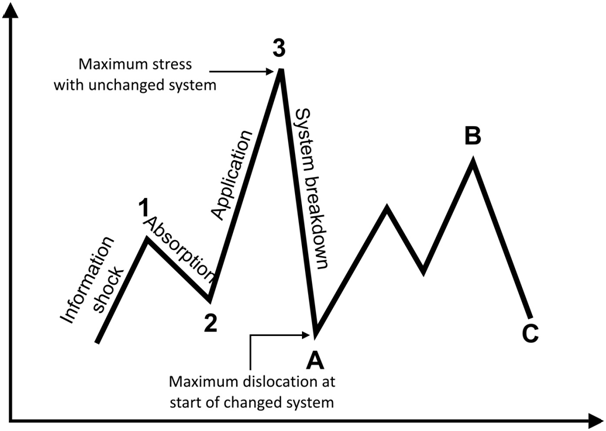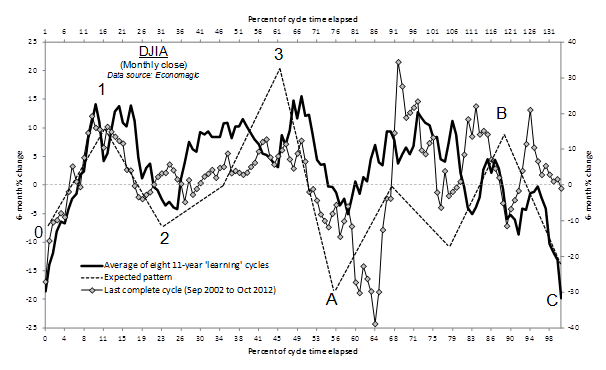The
Law of Vibration
The Law
of Vibration
Article
by Tony Plummer, Author, The
Law of Vibration, The
Revelation of
William D. Gann
The name William D. Gann inevitably evokes a variety of responses –
ranging from irritation that people can still believe any of the claims
that are associated with him, to enthusiasm for his ability to evoke in
traders a certainty that they can be successful. For many years, my own
attitude has fallen somewhere between these two points of view. On the
one hand, I have always thought that there was a great deal of truth in
his claims that he had access to a great secret; on the other hand, I
doubted that his extant material actually revealed that secret.
Indeed,
I have long suspected that WD Gann did have access to uncommon wisdom
but that later in life, and because of his religious convictions, he
tried to deflect public attention from the more esoteric aspects of his
understandings.
Whether or not this is true, he nevertheless buried the
central pattern of the Law of Vibration in his rather strange book, The
Tunnel Thru The Air. He may have done so, and then wished he hadn’t; or
he may have purposefully buried it for some future use. We’ll
probably never know.
That the pattern hidden in Tunnel is associated with a general Law of
Vibration can be deduced from the fact that he was not the only person
to have used it. WD Gann himself persistently maintained that his
original source was Chapter 12 of St Matthew’s Gospel in the Christian
Bible. As strange as it may seem, it turns out that a very similar
pattern was hidden exactly where Mr. Gann said it was. The key that
turned the lock was a realisation that St. Matthew had used the ancient
science of numbers, known as gematria, in his work. This means that
knowledge of the pattern behind the Law of Vibration is at least 1,900
years old. The anomaly, however, is that there is no (obvious)
indication in St. Matthew’s work about how the ‘Law’ was supposed to
work. So, what was its purpose?
Part of the answer is that a simplified version of the pattern was used
by the great mindfulness proponent George Gurdjieff, in the early years
of the 20th century, to demonstrate the inner workings of cyclical
behaviour. Furthermore, Mr. Gurdjieff also hid the advanced version of
the pattern in one of his major books. There is no clear evidence that
Mr. Gann and Mr Gurdjieff ever met, but the parallels between the two
men are quite striking: they lived at the same time; they both promoted
meditational practices; and their paths may well have crossed in the
US. What is particularly striking is that both men used exactly the
same method of hiding the pattern in their books.
So what is this pattern? My work over the years had already revealed
that cyclical activity in collective behaviour was not only a fact but
also that it had a very specific configuration that was different to
the sine wave model that was
usually used by cycle analysts. In
particular, I found that cyclical behaviour normally contains a sharp
fall somewhere between one-third and one-half of the cycle’s length.
This I had called an “energy gap”. My research also suggested that the
whole pattern was a reflection of the processes of learning and of
evolutionary change. My inference was that collective behaviour, both
in financial markets and in economic activity, oscillated in a way that
reflected an adjustment to information from the environment. The
pattern itself is shown in the diagram below (The notations are mine,
not William Gann’s.)
 Figure 1 The
Law of Vibration: Patterns of Cyclical Behaviour
Figure 1 The
Law of Vibration: Patterns of Cyclical Behaviour
An information shock is received from the environment, and the system
begins to respond. However, it has to go through a phase of absorbing
the information; and so activity slows. This is exactly what
happens when an individual is learning a mechanical task. In a
financial market, the configuration might be the initial jump from the
oversold low in a bear followed by a re-test of that low. After this,
the collective grouping can actually implement its learning without
wasting energy. This is the trend in a bull run.
The insight from this pattern of vibration, however, is that the
application of learning (or the bull run) is not going to last forever.
Eventually, the system does run out of energy. In a bull run, prices
will eventually run ahead of fundamentals. What seems to happen is that
an unchanged system basically gets stressed and vulnerable to an energy
gap. In a financial market, therefore, short-term exit signals have
longer-term implications; prices reverse suddenly and drop a long way.
It is possible to see this process at work in major financial crises,
including that of 2007-09. But it also happens all the time on a
smaller scale. Elliott Wave technicians, for
example, might come across
it at the beginning of a 4th wave correction.
The point is, however, that this is not the end of the pattern, or of
the cycle: the system is dislocated, but not broken; and a financial
market becomes very oversold. There is then a recovery. Participants
re-apply their learnings from the original information shock and its
aftermath, and genuine evolution starts to occur as resources that have
been released during the energy gap are re-assigned. This recovery has
a three-wave profile, which continues until the energy again runs out.
Then comes the final downswing of the cycle. In financial markets this
is the bear that very few expect; in the economy it is the ‘second dip’
to the recession.
Not surprisingly, of course, this pattern of vibration is not always
easy to identify. It is, for some reason, easier to find in commodity
markets and in inflation indices than it is to
find in equity and bond
markets. I suspect that this has something to do with the primal nature
of inflation, which seems to be more prone to what economists call
“exogenous” shocks. Equity and bond markets – and, for that matter,
economic activity – usually reflect a pattern that is instead a
derivative of the learning cycle. If the learning cycle were to be
expressed in absolutes, the derivative pattern would be expressed in
terms of momentum. What this means is that, in effect, the learning
cycle becomes stretched out into an information shock followed by three
sub-cycles. The sub-cycles are of equal length, but each has a
different (evolutionary) role to play. It is these sub-cycles that
conventional cycle analysts can most easily identify. The catch,
however, is that they have to be separated from the information shock,
which is why analysts can become so frustrated when the oscillations of
a well-researched and reliable cycle suddenly seem to disappear.
Learn.
Practice. MAKE MONEY!
With a Stock Market
INVESTING course Click
Here
This configuration – of an information shock followed by three cycles –
was, perhaps, one of the most intriguing aspects of Mr. Gann’s own
pattern. His original pattern takes the same overall shape as the
learning cycle shown above, but it is much more complex. This was the
clue that there might be other information hidden within it; it is, in
effect, a carrier wave. And, when his pattern was translated into a
momentum series, the classic pattern of a shock followed by three
cycles became readily apparent. In practical terms, it is always
necessary to isolate the information shock (which invariably is a sharp
rise followed by a contraction); however, having done that, it is
useful to average all the sub-cycles together. First, the averaging
process should reveal the same archetypal pattern as the learning cycle
(and isn’t that in itself extraordinary?). Second, it is then possible
to plot the evolution of the current cycle against that average.
An example of this process is shown below. The stock
chart below shows the US
equity market, as represented by the DJIA. The heavy line is the
average of eight 10- to 11-year cycles (ie, after eliminating the
information shocks), dating back to 1910; the thinner line with the
triangular marking is the last complete cycle, which ran from September
2002 to October 2012; and the dotted line is the expected pattern. The
correlations are remarkable, even if they are only going to be used as
a general guide to energy trends. What the comparison tells us is that
a big cycle ended last October – which is why the market has
subsequently jumped so sharply – but that the move since then is almost
certainly part of an information shock. Such shocks have the standard
pattern of an advance followed by a very deep contraction, and they
tend to last about 40 months.
 Figure 2: The
Law of Vibration Complete Behaviour Cycle Pattern (DJIA Monthly)
Figure 2: The
Law of Vibration Complete Behaviour Cycle Pattern (DJIA Monthly)
My research suggests that during the
advance phase of a shock period, there is likely to be an interim
contraction that will be worth trading; but, at the moment, the target
date for the beginning of a cyclical bear centres on early 2014. I
shall only change this view if my long-term stops
are prematurely
triggered.
The presence of a specific pattern
that reflects a response to
information can be taken as the signature of life. If so, it opens up
huge scope for research in other disciplines, such as sub-atomic
physics and cosmology. Imagine what the implication would be if the
same pattern were to be found in the evolution of galaxies. In
addition, it is worth adding that close analyses of Mr. Gann’s pattern,
of George Gurdjieff’s pattern, and of the methodology used by to hide
St Matthew’s pattern, reveals some startling new insights into
financial market behaviour.
It appears, for example, that the idea of
‘squaring price with time’ that is associated with Mr. Gann is
different to that which is commonly used. It also seems that Mr. Gann’s
support and resistance levels are
derived – with very good reason –
from the musical octave. For Gann enthusiasts, they are worth analysing
in more detail.
Tony
Plummer, Helmsman Economics Ltd>
Author,
The Law of
Vibration: The Revelation of William D. Gann
Available
from Amazon or from Harriman House
 |
The Law of Vibration
The revelation of William D. Gann
By: Tony Plummer
Format(s): Paperback
ISBN(s): 9780857192592
Published: 25 February 2013
Edition: 1st
Publisher: Harriman
House
Available from: Harriman House and Amazon |
|
|
|
|